

Instructional Coaching. Social and Emotional Learning. Receiving Feedback With Grace and Dignity. Are you interested in hearing about how others view your work and your contribution?
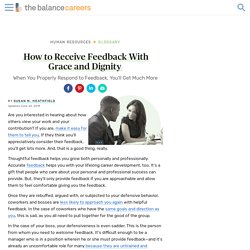
13 Resources on the Keys to Effective Feedback - ASCD Inservice. Effective student feedback consists of a few key elements that bring about positive change in student performance.
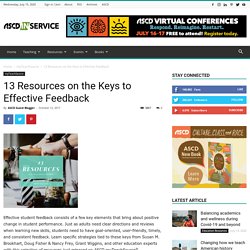
Just as adults need clear directions and reviews when learning new skills, students need to have goal-oriented, user-friendly, timely, and consistent feedback. Learn specific strategies tied to these keys from Susan M. Brookhart, Doug Fisher & Nancy Frey, Grant Wiggins, and other education experts with this selection of resources just released on ASCD myTeachSource®.
For more resources on effective feedback instructional practices, go to ASCD myTeachSource and sign up for a free two-week trial. Free The Secret of Effective Feedback (Educational Leadership) Co-Planning Guide for Managing Learning Environment Template (Copy and Use) Reflective Teaching: an Element of Life-Long Learning. 10 Ways To Be A More Reflective Teacher. 10 Ways To Be A More Reflective Teacher by Terry Heick Teaching isn’t easy.
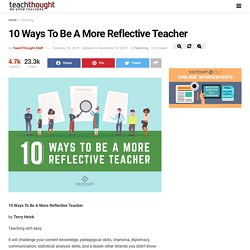
It will challenge your content knowledge, pedagogical skills, charisma, diplomacy, communication, statistical analysis skills, and a dozen other strands you didn’t know where strands. Some teachers may try to tell you that being happy doesn’t matter. That it’s about results. Teaching is about the students, but guess what? A key factor in happiness can be perspective, and a factor in effectiveness can be reflection. Grade 9-12 Video. Grade 3-5 Lesson Video. Co-Planning Guide for Managing Learning Environment Template (Copy and Use) The Secret To Perfect Transitions In 5 Simple Steps. Transitions are among the most perilous times of the day. The frenetic movement, the close interaction, the loud voices and sense of freedom . . . All conspire to increase the likelihood of misbehavior.
Transitions can also waste precious learning time, bring tension and excitability to the classroom, and make it difficult to settle students back into a state of attentiveness. It’s a rare week that we don’t hear from at least one teacher requesting help in this area. A common complaint is that every transition is different and therefore can’t be replicated like an everyday routine. But here’s the thing: Where students are going, or coming from, isn’t the transition. The transition is the space between. If you standardize these brief moments, if you do the exact same thing regardless of where you’re transitioning to or coming from, they’ll be predictably smooth every time. Here’s how in five simple steps: 1. 2. Example: “In a moment, we’re going to begin a vocabulary lesson.” Mastering Classroom Transitions.
There are essentially three types of transitions: entering class and taking a seat, switching from one academic activity to another, and exiting class.
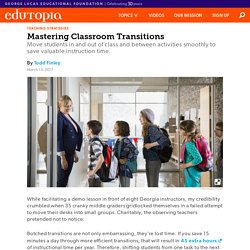
And just like any academic procedure, transitions are taught through explicit explanations, clear models, rehearsal, and review. Whether students are transitioning from reading to math, or PE to the drinking fountain, author Mike Linsin recommends standardizing the process with five steps that I paraphrase this way: Secure students’ attention: “Focus on me, please.” Explain the procedure: “In a moment, return to your desks and take out your history textbooks.” Prepare kids for the signal to start: “When I say ‘smooth,’ you’ll quietly proceed.” Troubleshooting When transitions take too long or learners misbehave, it’s time to don your figurative Sherlock Holmes deerstalker hat and reflect on these questions: Did I provide too many or too few directions? After answering those questions, try some of the techniques described below. Whole Brain Teaching by Kaitlyn Morris.
3 Steps to a More Accessible Classroom. Learn simple but important ways to evaluate your edtech choices.
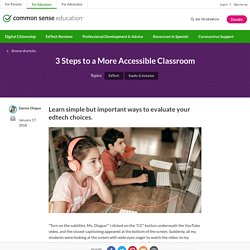
"Turn on the subtitles, Ms. Olague! " I clicked on the "CC" button underneath the YouTube video, and the closed-captioning appeared at the bottom of the screen. Suddenly, all my students were looking at the screen with wide eyes, eager to watch the video. In my first-grade classroom, a third of my students were learning English as a second language. My students loved having subtitles on during short videos because it gave them more opportunities to interact with and learn from the content.
Any classroom teacher will tell you the importance of differentiating instruction and materials for students' diverse needs. Evaluating Accessibility The next time you introduce a new digital learning tool, consider these three key questions to help ensure you're meeting all your students' needs. 1. The definition of "easy" will depend on the target age. 2. The text should be legible and in a clear font that can be enlarged. How to Arrange a Classroom for Physical Disabilities - BrightHub Education. Students with physical disabilities using assistive devices such as wheelchairs or crutches must have a classroom that is accessible for classroom supplies and other learning materials.
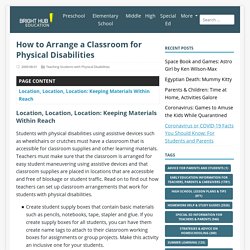
Teachers must make sure that the classroom is arranged for easy student maneuvering using assistive devices and that classroom supplies are placed in locations that are accessible and free of blockage or student traffic. Read on to find out how teachers can set up classroom arrangements that work for students with physical disabilities. Create student supply boxes that contain basic materials such as pencils, notebooks, tape, stapler and glue. If you create supply boxes for all students, you can have them create name tags to attach to their classroom working boxes for assignments or group projects.
Make this activity an inclusive one for your students.Use an open cabinet with wide shelves to store student supply boxes.